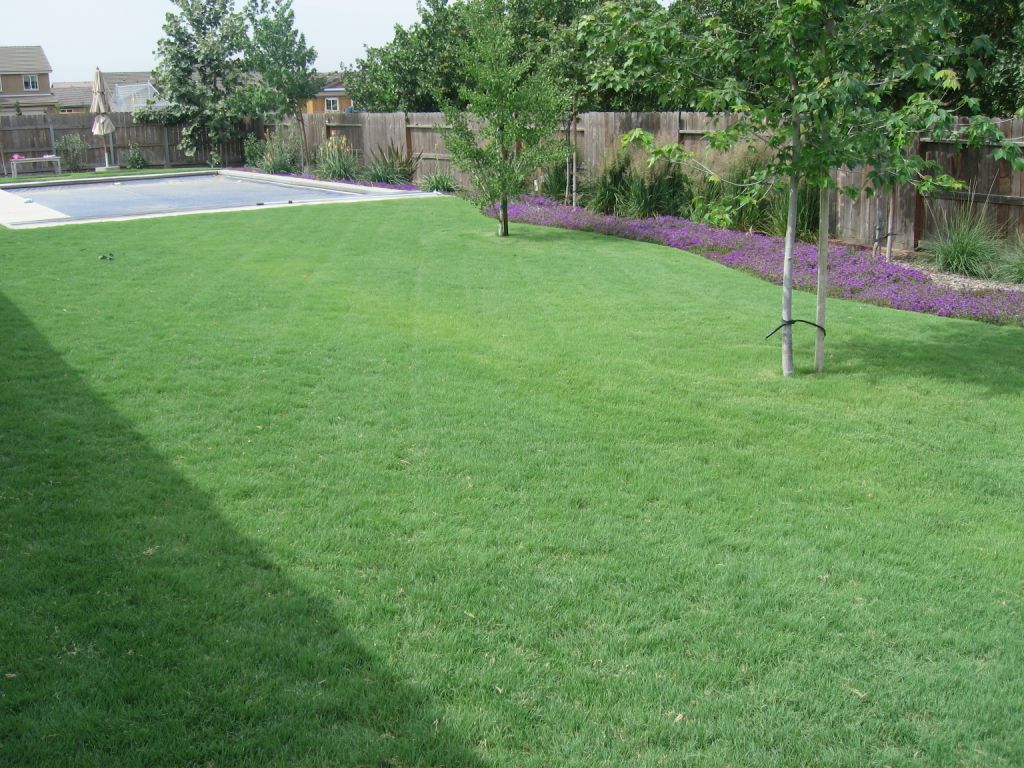
Reference the FAQs below for quick answers. See the PDF link at the bottom for more detailed information.
When to Plant?
Though it is possible to plant ‘UC Verde’® Buffalograss year round, being a warm season grass, the optimal time for planting is between April 1st and August 15th, in order to take full advantage of the warmer night and day temperatures, and the longer days experienced at this time of year for rapid establishment.

*Can be planted at this time but growth will be slowed. Please inquire for special instructions for planting during these months.
How many Plugs?
Divide planting area square footage by 128 (# of plugs/tray) to get the number of trays needed.
SQ FT / 128 = # of trays
Example: 400 / 128 = 3.125 trays.
We only sell full trays so you can round up or down and space your planting accordingly.
Note: for most of California, 12” on center (o.c.) is appropriate spacing for residential planting, unless fast fill-in is desired, in which case 9” is recommended. For large projects like parks, 15” o.c. is okay but fill in time will be 4-8 weeks longer.

Rate of fill-in is a direct function of spacing and time of planting. If planting during optimal growing time at recommended spacing you should have full coverage in 12-14 weeks in inland areas and slightly longer in coastal regions.
Site Preparation
Proper site preparation is very important to the success of your planting. This process may take long but is worth it! It will save you time and effort in the future.
New Lawns: All areas to be plugged should be free of construction debris, stones, living vegetation, etc. If large weed population is expected, a pre-emergent herbicide like Ronstar can be surface applied after planting (DO NOT SOIL INCORPORATE). Make sure all established grades are maintained to insure proper drainage. Renovated Lawns: For lawn conversions involving a healthy COOL SEASON grass like tall fescue, the old lawn may be removed with a sod cutter, or may be killed with a non-selective herbicide such as Round-Up, following label instructions. NOTE: IF PRIOR LAWN HAS BERMUDA, KIKUYU OR ANY OTHER RHIZOTOMOUS GRASS, DO NOT PLANT PLUGS WITHOUT PROPERLY GETTING RID OF THESE VERY INVASIVE GRASSES! We recommend a ‘triple grow-kill cycle’ for these, where application of non-selective herbicide is followed by a period of watering the area in to promote new growth; repeated 2- 3 times to ensure eradication of the persistent rhizomes.
Receiving Plugs
Immediately open boxes upon arrival. Place plugs in an open area in half-day sun, preferably protected from wind. Avoid delaying plug planting by more than one week. Plug trays will need to be kept adequately watered during any holding period; this may be once or more a day in very hot weather if plugs are not in a shady area.
Planting
Make sure that plugs are well-watered before planting. If plugs are dry, hand water or soak the plug tray in a large container or sink.
A soil with tilled or loose to depth of 4” is easily planted by hand; harder soils may benefit from use of a soil auger to make holes for planting.

Start next to a sidewalk, building, etc. Dig or drill a 1 ¼” diameter hole about 1 ½” –inches deep. Place a plug into the hole, being sure the plug is to the bottom of the hole. Failure to place plug firmly to the bottom of hole will create an air pocket under the plug, which will reduce the chance for survival.
Planting plugs too high (above soil level) may lead plugs to air wick dry which can also lead to plant loss. The top of the plug soil should be slightly below ground surface. Measure for the next plug, using the specified spacing. Repeat installation procedure. Continue in a straight line to the end of the planting area. Move the specified spacing for the second row and continue planting. Stagger plugs as on diagram:

Irrigation
Once established ‘UC Verde’® has extremely low irrigation needs. New plantings will however require frequent light irrigations to prevent plugs from drying out. Depending on time of planting, soil type and weather, plugs may need to be watered daily and in very hot weather maybe more often for the first 3-4 weeks.
Water-in plugs thoroughly after planting. Maintain area by keeping plugs and soil moist for approximately 21 days. Avoid extremes of letting the plugs go bone dry or keeping them boggy. After this period, slowly reduce the frequency of watering.
During the growing in period, plugs require adequate moisture to allow the stolons to root into the ground. If stolons do not attach to the ground, water lighter amounts with increased frequency and add ¼” lawn topper to help retain surface moisture. Once complete coverage is achieved, water to prevent stress. Watering frequency and amounts will vary with soil type, clay soils requiring less water and sandy soils requiring more frequent watering.
Once filled in, switch watering schedule to infrequent but deep irrigations to drive the roots deeper and increase drought tolerance. In most areas and for most soil types, an established ‘UC Verde’® lawn can get by on one deep irrigation every 7-10 days.
Note: If soil surface is drying out quickly between irrigations during lawn fill in period, the addition of a fine lawn topper (compost) at planting will enhance surface moisture and allow for faster rooting and spread of stolons, apply no more than ¼” of topper.
Fertilization
Fill in time can be reduced by providing an initial feeding for the plugs following the first irrigation with a liquid feed fertilization, using a Miracle Gro 15-30 or a similar product.
A light, monthly fertilization will speed up coverage/fill in time. If soil fertility is low or suspect at time of installation, in addition to applying a starter fertilizer you can also apply a high quality slow-release lawn fertilizer, following recommendations on label for new lawns. Depending upon label instructions, you may want to re-apply every 30 days during the growing season until the complete grass coverage is achieved. Be sure to water in well.
For established ‘UC Verde’® lawns, apply 2-3 lbs nitorgen per 1000 square feet annually. This is best divided into 5 fertilizations during the growing season: late February, mid-April, late May, mid-July, early September.
Weed Control
After the initial watering, remove any weed seedlings by hand/hoe. An appropriate pre-emergent herbicide labeled for use of Buffalograss (Buchloe sp.) may be applied to control weeds during “grow-in” period if desirable. Follow label instructions. After application, thoroughly water the area. Pre-emergent treatment may be repeated if needed within 8 weeks; follow product label. If broadleaf weeds develop, remove by hand or apply a non 2-4D broadleaf herbicide. Ready to spray products that attach to garden hose are easy to use; be sure to find a product that is labeled for use on Buffalograss (Buchloe sp.).
Pests and Diseases
Rabbits may be attracted to the fresh growth of the young plants and can chew the plugs down to a nub, so best keep them away for the first 4-6 weeks with fencing. If this is not practical, note that the ‘UC Verde’® can be planted slightly deeper, placing the crown of the plant ¼ to ½” or so below soil level. By doing so, rabbits may graze but will not harm crown of plant. Sprinkling sand on the new plugs may also deter rabbits from chewing.
Crows may be attracted to the newly planted area and have fun pulling up recently planted plugs. If noise does not deter them we have seen some success with motion activated sprinklers such as Scarecrow Motion Activated Sprinkler, Orbit Yard Enforcer, Havahart Spray Away, etc.
Mowing
Initial mowing should be approximately 3 to 4 weeks after planting, once plugs have rooted in. This will promote stolon growth and fill in time. Do not remove more than 1/3” of top growth to avoid scalping the lawn. Subsequent mowing schedule should be about half that of a fescue lawn for a groomed look. For a short meadow look, do not mow regularly, but just one to two times during the growing season (April-October) to invigorate the lawn. (NOTE: If your mower or that of your gardener has been used on other lawns, especially lawns with Bermuda or Kikuyu, make sure that the mower housing and blades are clean and free of these clippings; these grasses are considered invasive and the cut sections can become established in your new lawn.)
